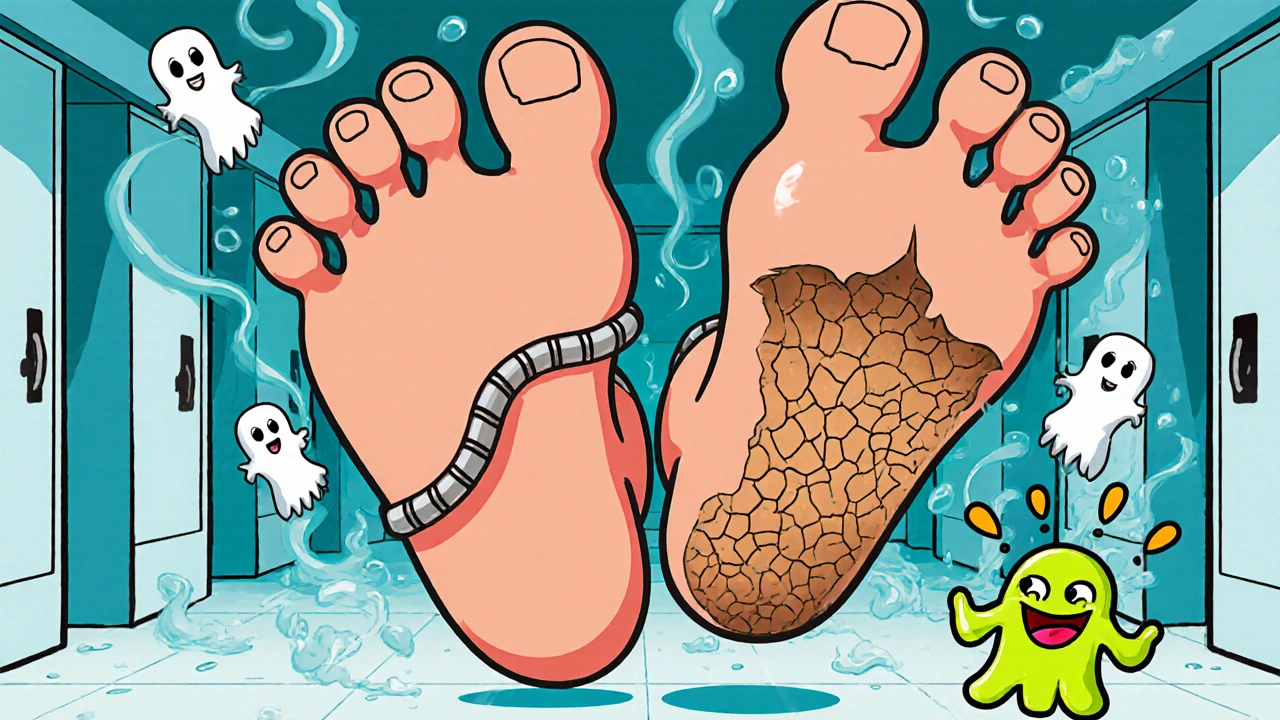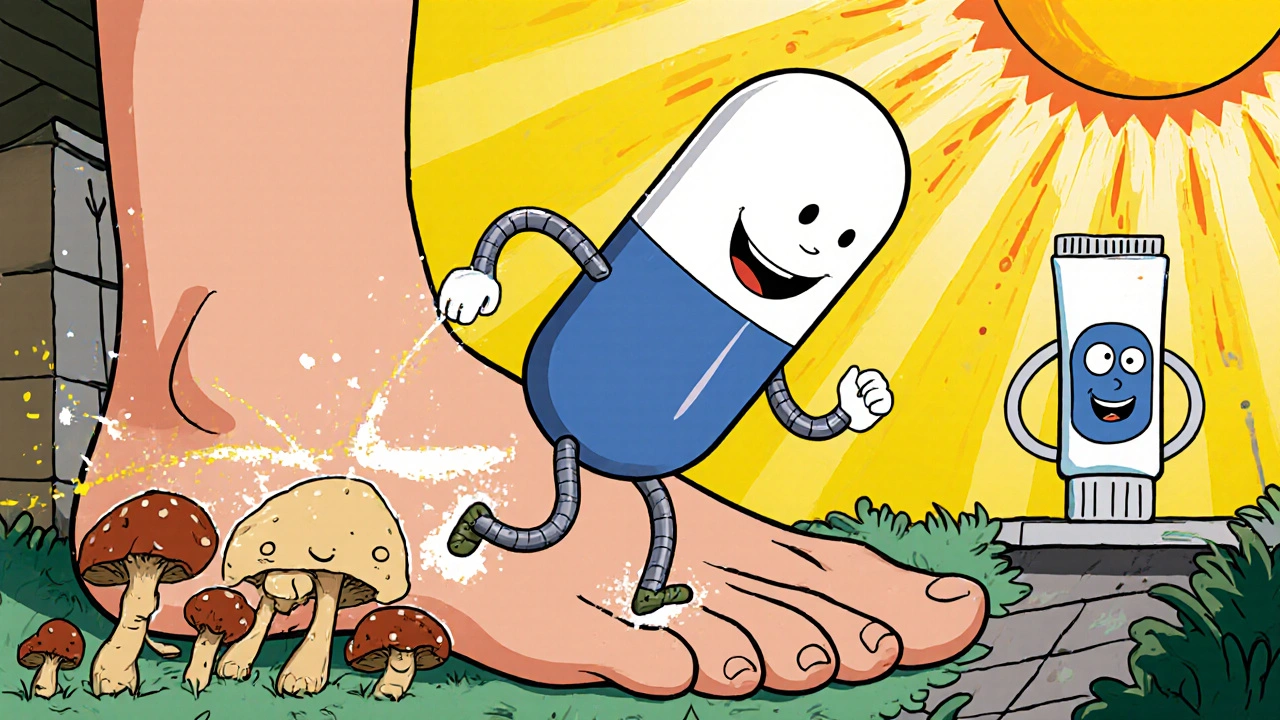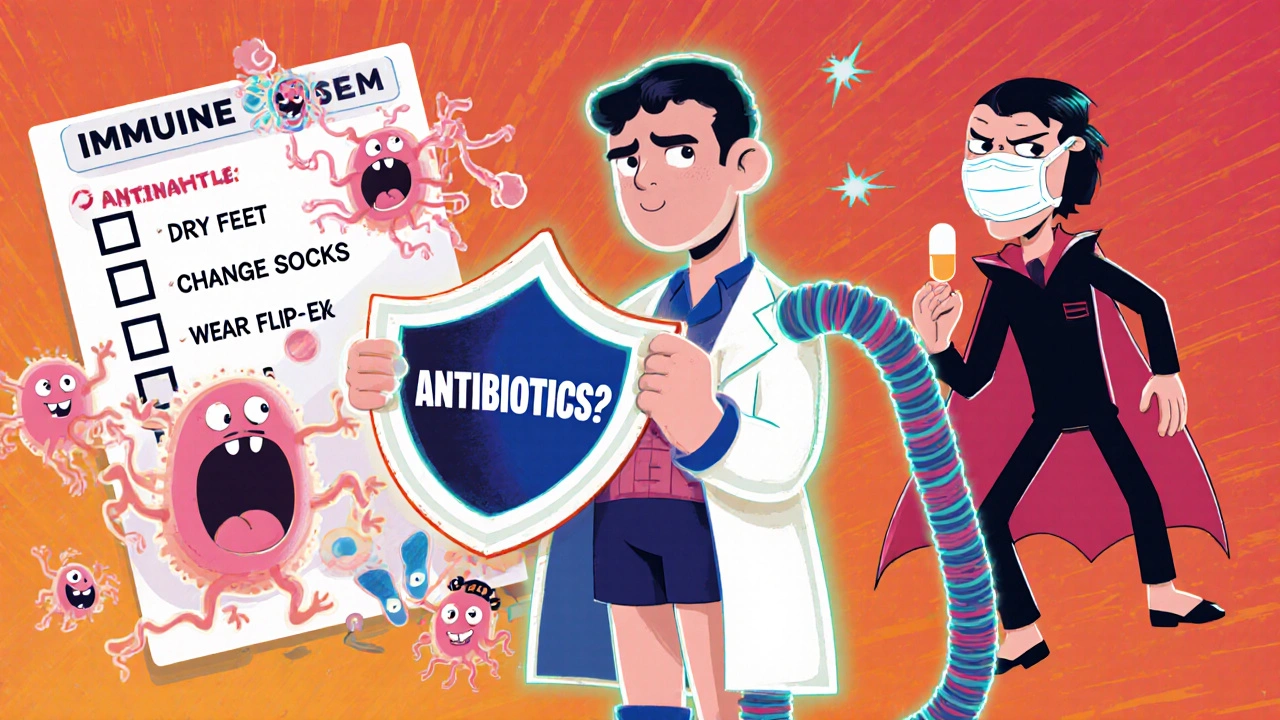
Most people think fungal infections are just a nuisance - itchy feet, a little rash, maybe some flaky skin. But if you’ve had one, you know it’s more than that. It lingers. It comes back. And if you ignore it, it can get worse. Athlete’s foot and candida infections aren’t rare. They’re everywhere. In locker rooms, in sweaty shoes, in the warm folds of skin after a shower. And while they’re often dismissed as "just a fungus," they can turn serious - especially if you have diabetes, a weak immune system, or don’t treat them right.
What’s Actually Growing on Your Skin?
Not all fungal infections are the same. The two most common types - athlete’s foot and candida - are caused by completely different organisms, and they behave differently.
Athlete’s foot, or tinea pedis, is caused by dermatophytes. These are fungi that eat keratin - the tough protein in your skin, nails, and hair. That’s why they love your feet. They thrive between your toes, especially the fourth and fifth ones, where sweat gets trapped and air doesn’t circulate. The most common culprit? Trichophyton rubrum. It’s everywhere. In gym floors, public showers, even your own towel if you don’t wash it.
Candida, on the other hand, is a yeast. Candida albicans is the usual suspect. It lives naturally in your mouth, gut, and vaginal area. Normally, your body keeps it in check. But when your immune system is off - from antibiotics, stress, diabetes, or hormonal changes - it overgrows. That’s when you get oral thrush, vaginal yeast infections, or a red, itchy rash in skin folds.
The big difference? Dermatophytes only attack keratinized tissue. Candida can invade both keratinized and non-keratinized areas. That’s why candida can turn systemic in people with weakened immunity. Invasive candidiasis kills up to 40% of those who get it. Athlete’s foot? Rarely deadly. But it can lead to bacterial infections like cellulitis if left untreated.
Types of Athlete’s Foot - And What They Look Like
Athlete’s foot doesn’t look the same on everyone. There are three main types, and knowing which one you have helps you treat it right.
- Interdigital (70% of cases): This is the classic case. Peeling, cracked skin between the toes, often with a white, soggy look. It stings when you walk barefoot. This is where Whitfield’s ointment (a mix of salicylic and benzoic acid) works best - it softens and peels away the dead skin so the antifungal can reach the fungus underneath.
- Moccasin type (20%): Dry, scaly skin covering the soles and sides of your feet. It looks like you’ve got a bad case of eczema. It’s stubborn. Often mistaken for dry skin, so people don’t treat it. But it’s fungal. And it spreads.
- Vesicular/bullous (10%): Small blisters on the foot. These can burst and ooze. They’re more inflamed and often signal a secondary bacterial infection. If you see pus or feel feverish, see a doctor.
Here’s a key thing most people miss: athlete’s foot doesn’t go away on its own. A 2023 Cleveland Clinic study showed that 67% of patients who finished their full treatment got rid of it. Only 32% who quit early saw results. If the itching stops after a few days, that doesn’t mean the fungus is gone. You’ve got to keep going.
How Antifungal Treatments Actually Work
Not all antifungals are created equal. The medicine you pick depends on the infection, how bad it is, and where it is.
Topical treatments - creams, sprays, powders - are your first line for mild cases. The most common ones:
- Azoles (clotrimazole, miconazole): Kill fungi by disrupting their cell membranes. Effective for mild athlete’s foot. Cure rate: 70-80% in 2-4 weeks.
- Allylamines (terbinafine): Kill fungi faster. They target an enzyme the fungus needs to build its cell wall. Terbinafine cream cleared 6-month cases in 10 days for many users on Reddit, while clotrimazole failed after 3 weeks. It’s also the top-rated OTC product on Trustpilot, with 78% of users seeing improvement in under a week.
- Whitfield’s ointment: Not a traditional antifungal. It’s a keratolytic. It peels off dead skin, letting the antifungal get deeper. DermNet NZ found it cleared 65% of interdigital cases in 4 weeks - better than clotrimazole alone.
For stubborn cases - or if the infection is on your nails or has spread - you need oral meds:
- Terbinafine (250 mg daily for 2-6 weeks): Best for dermatophytes. 85-90% cure rate.
- Itraconazole (200 mg daily for 1-2 weeks): Works on both dermatophytes and some candida.
- Fluconazole (150 mg weekly for 2-4 weeks): The go-to for candida infections, including vaginal yeast infections.
Here’s the catch: topical treatments have a 40% recurrence rate within a year. Oral treatments? Only 15-20%. Why? Because creams can’t reach deep enough. The fungus hides in the skin layers. Oral drugs go through your bloodstream and hit it from the inside.

When to See a Doctor
You don’t need to rush to the clinic for a little itch. But if you see any of these, get help:
- Redness spreading beyond the foot
- Pus, swelling, or warmth in the area
- Fever
- Diabetes or a weakened immune system
- No improvement after 2 weeks of OTC treatment
Doctors can do a skin scraping test - quick, painless - to confirm it’s fungal and not eczema or psoriasis. They’ll also check for bacterial infections. As dermatologist Amanda Oakley notes: "Very inflamed athlete’s foot is usually due to a bacterial infection, not the fungus itself."
And if you’ve had recurrent infections - especially vaginal yeast infections - your doctor might test for underlying issues like prediabetes or immune disorders. A 2023 CDC report found that 75% of women will have at least one yeast infection in their life. But if it’s happening every few months, it’s not normal.
Prevention Is the Real Cure
Treatment works. But if you don’t change your habits, it’ll come back. Here’s what actually helps:
- Keep feet dry. Fungi grow in moisture. After showering, dry between your toes with a clean towel. Use a hairdryer on low if needed.
- Change socks daily. Cotton or moisture-wicking socks are best. Avoid synthetic materials that trap sweat.
- Avoid walking barefoot in public. Locker rooms, pools, hotel bathrooms - these are fungal hotspots. Wear flip-flops.
- Don’t share towels, shoes, or nail clippers. Fungi shed skin cells. Those can live on surfaces for weeks.
- Use antifungal powder. Sprinkle it in your shoes and socks. Powder with 2% miconazole helps control moisture and kills lingering spores.
- Let your shoes breathe. Rotate them. Don’t wear the same pair two days in a row. Sunlight kills fungi - leave them outside for a few hours.
And here’s a tip most people ignore: apply antifungal cream 1 inch beyond the visible rash. The fungus spreads under the skin before you see it. Stopping at the edge is like putting a bandage on a bullet wound - it won’t work.

What’s New in Fungal Treatment
The last 5 years have brought real progress.
In 2021, the FDA approved Ibrexafungerp (Brexafemme) - the first new class of antifungal drug in 20 years. It’s for vaginal yeast infections that don’t respond to fluconazole.
In 2023, a new topical drug called olorofim showed 82% cure rates in Phase II trials for stubborn athlete’s foot. It works against strains resistant to current drugs.
And the CDC’s "My Action Plan" - a foot care program for people with diabetes - cut recurrent fungal infections by 35% in participating clinics. It’s simple: daily foot checks, moisturizing (not between toes), and regular podiatrist visits.
But there’s a warning. A new super-fungus, Trichophyton indotineae, has spread from India to 28 countries. It’s resistant to terbinafine. Experts predict antifungal resistance will rise 50% by 2030. That’s why using meds correctly matters - don’t stop early, don’t share them, don’t use leftover pills.
What You Should Know About Recurrence
Why does it keep coming back? It’s not your fault. It’s the fungus.
It hides. In your shoes. In your socks. In the grout of your bathroom floor. Even after you feel better, spores are still alive. That’s why treatment must continue for 1-2 weeks after symptoms disappear.
One user on Drugs.com said: "Stopped clotrimazole after 3 days when itching stopped. Came back worse two weeks later." That’s the pattern. The fungus isn’t gone - it’s just quiet.
And if you’ve had athlete’s foot once, you’re more likely to get it again. Studies show recurrence rates jump to 60% in people who don’t follow prevention steps.
The solution? Treat it. Then keep treating your environment.
Final Takeaway
Fungal infections aren’t glamorous. But they’re common. And they’re treatable. Athlete’s foot and candida aren’t signs of poor hygiene - they’re signs that your skin’s defenses were overwhelmed. That can happen to anyone.
The key is knowing the difference between the two, using the right treatment, and sticking with it. Don’t stop when it feels better. Clean your shoes. Dry your feet. Don’t walk barefoot in public spaces.
Most cases respond well to OTC creams. But if it doesn’t clear up, or if you’re at risk for complications, see a doctor. There are better options now than ever before - and ignoring it won’t make it go away.

 Health and Wellness
Health and Wellness
robert cardy solano
November 20, 2025 AT 04:44Been dealing with this for years. Stopped using regular socks and switched to bamboo ones - game changer. Also started leaving my shoes outside for a few hours after work. No more recurrence since. Simple stuff, but nobody tells you this.
Brianna Groleau
November 20, 2025 AT 17:37I used to think fungal infections were just a hygiene issue until my mom got a candida flare-up after antibiotics and ended up in the ER with sepsis-like symptoms. It’s not a joke. My whole family now treats every little itch like it’s a bomb ticking. We disinfect towels, rotate shoes, use antifungal powder like it’s air freshener. I’m not exaggerating - it saved her life. If you’ve got diabetes or a weak immune system, don’t wait. Just do the work.
Rusty Thomas
November 22, 2025 AT 04:57WHY DO PEOPLE STILL USE CLOTRIMAZOLE?? 😤 I used it for 3 weeks, it did NOTHING. Then I tried terbinafine cream - itching gone in 48 hours. Like, I was like ‘did I just imagine the whole thing?’ No. The fungus was DEAD. Terbinafine is the MVP. Stop wasting your money on placebo creams.
rob lafata
November 23, 2025 AT 14:54Let me guess - you’re one of those people who think ‘natural remedies’ like tea tree oil or apple cider vinegar fix this. Nah. You’re just feeding the fungus. It’s not magic, it’s biology. And if you’re not using a proper antifungal with proven efficacy, you’re not treating it - you’re just delaying the inevitable. And now it’s resistant. Congrats.
Nick Naylor
November 23, 2025 AT 22:34Terbinafine resistance is a looming public health crisis - and it’s being ignored by Big Pharma because it’s not profitable enough. The FDA approved Ibrexafungerp, but it’s priced at $1,200 a course. Meanwhile, the CDC’s My Action Plan? Underfunded. We’re in a post-antibiotic era for fungi. And no one’s talking about it. This isn’t just about feet - it’s about systemic collapse.
Pawan Jamwal
November 25, 2025 AT 05:26In India, we’ve had Trichophyton indotineae for years. Everyone knows to use terbinafine for 6 weeks, not 2. You Americans think OTC creams are enough? LOL. We treat this like a war. Foot soaks with neem, antifungal powders, shoe disinfectants - no excuses. Your lax attitude is why it’s spreading.
Lemmy Coco
November 25, 2025 AT 18:39so i used terbinafine for 2 weeks and it felt better so i stopped… then it came back worse… i feel dumb now 😅
Matthew McCraney
November 26, 2025 AT 21:26They’re hiding it from you. Fungi are engineered by the government to keep people buying creams. Why do you think they never mention the 40% recurrence rate? Because if you knew how easy it is to prevent, you’d stop buying. Look at the CDC’s budget - 90% goes to vaccines, 1% to fungal education. Coincidence? I think not. Wear flip flops. Don’t be a sheep.
Cinkoon Marketing
November 28, 2025 AT 19:23Just a quick note - if you're using Whitfield’s ointment, don’t mix it with azoles unless you’ve talked to a derm. The acids can interfere with absorption. I learned this the hard way after burning my toe. Also, moisturize the rest of your foot - dry skin cracks and lets fungus in. It’s not just about killing the bug, it’s about fixing the environment.
Sarah Swiatek
November 29, 2025 AT 22:57Let’s be real - the real reason fungal infections come back is because we treat them like a chore, not a health priority. You wouldn’t stop taking antibiotics after 3 days because you ‘felt better.’ Why do it with antifungals? You’re not lazy - you’re just misinformed. And the fact that OTC labels say ‘use until symptoms disappear’ instead of ‘use for full course’? That’s not an accident. That’s negligence. Shame on the pharmaceutical industry for not correcting it.
serge jane
December 1, 2025 AT 06:50There’s something deeper here - we treat fungal infections like personal failures when they’re really just biological accidents. We shame people for athlete’s foot like it’s a moral flaw. But fungi don’t care about your hygiene habits or your socks or your shoe rotation. They just want warmth and moisture. And if you’re human, you give them that. The real enemy isn’t the fungus - it’s the guilt we attach to it. Treat it. Clean up. Move on. No need to punish yourself.
Bill Camp
December 2, 2025 AT 16:36Trichophyton indotineae is a bio-weapon. Russia and China have been stockpiling resistant strains since 2020. They know we’re vulnerable. Our healthcare system is broken. Our pharmacies sell placebo creams. Our government ignores it. This isn’t a health issue - it’s a national security threat. Wake up.